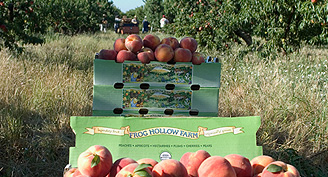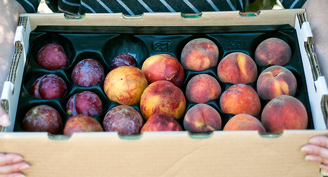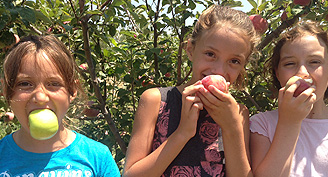History of the Ferry Plaza Farmers’ Market
by Sibella Kraus
Shoppers—in groups of one and two and small tribes—move from stall to stall at a weekend pace. They feast their eyes on the bountiful displays of seasonal produce and flowers, sampling here and there, and pause to chat with one another and with the farmers. No one seems to have a list. The regulars fill their tote bags with favorite foods of recent weeks and still leave room to discover the new finds of the season. Social life in the market plaza echoes this mix of routine and serendipitous; it’s a place for meetings with friends and chance encounters with old acquaintances. Conviviality comes naturally in the exhilarating setting. The market plaza is anchored by the graceful mass of the Ferry Building and looks out over the bay—sparkling or steely depending on the weather, but always good for a deep breath of salt air.
Like many successful redevelopment projects, the market has the feel of a place that has always been there. In fact, it opened in 2003, but the foundations of this vital urban market—the food culture and the location—have a long history and a fortuitous connection.
Abundant, varied local foods have always been part of what makes San Francisco a great city. Newcomers from all over Asia, Europe, and the Americas brought with them a rich array of culinary traditions. As California was settled, farmers produced an ever-increasing bounty and variety of agricultural products from the state’s fertile soils and benign climate. Commodity crops became the backbone of both the agricultural and the overall economy. At first labeled “alternative agriculture,” organic and specialty-crop farming emerged during the 1970s and 1980s as a movement that eschewed the mass-production ethic in favor of healthy food, healthy farms, and food with flavor. Initiatives such as the Farm-Restaurant Project introduced Bay Area chefs, longing to find more flavorful ingredients, to local organic farmers eager to find appreciative markets. The term California cuisine quickly became synonymous with cooking that was a celebration of ingredients. Linking farmers directly with chefs and, of course, consumers brought “hippie” produce companies into the mainstream, spurred a burgeoning farmers’ market movement, and made cities dream of building or reviving great public markets.
For much of a century, the Ferry Building, the grand and iconic port of entry to San Francisco, was a center of public life. Then came the decades of ignominy, as an elevated freeway cut off the city from its waterfront and consigned the building to a grimy facade and chopped-up office uses. In thirty seconds in 1989, the Loma Prieta earthquake accomplished what years of public advocacy had not. Damaged beyond repair, the freeway was demolished a year later. Ten years of public debate followed, with the city working through how best to use this “gift” of a ten-acre urban space, a reconnection of city and waterfront, and the virtual reappearance of the landmark Ferry Building.
In 1991, the two histories converged: the saga of the Ferry Building, now ready for a new lease on life, and the San Francisco food movement, equally ready for a fitting showcase for the region’s extraordinary agricultural bounty. Cosmopolitan San Francisco residents were well aware of the important role public markets play in great cities in the world. At the same time, the administration of then-Mayor Dianne Feinstein had been following the emerging public-market movement in other U.S. cities.
It was the initiative of developers Joe Weiner and Tom Sargent that got the ball rolling. A few years earlier, they had developed a public-market plan as a reuse for one of the waterfront piers. Now, in the revitalization of the central Embarcadero, they saw the opportunity to create a public market in the Ferry Building. As a starting point, they proposed to the Port of San Francisco a simple Saturday farmers’ market in the four-acre space left vacant by the demolished freeway. The port was skeptical but agreed to a one-time market event. Tom asked me to organize it and put up his own money to fund it.
On a glorious Saturday in September 1992, over ten thousand people streamed into the Embarcadero to buy produce from over one hundred of the best local organic and specialty-crop farmers, to feast on “street food” made by over a dozen of the city’s best restaurants, and to rediscover the waterfront. There was no turning back. In May 1993, the Ferry Plaza Farmers’ Market opened as a weekly certified farmers’ market. It was the city’s third market—the Alemany market opened in 1942, and Heart of the City was launched in 1980—and decidedly its most upscale.
The Ferry Plaza Farmers’ Market was operated by a newly created organization, the San Francisco Public Market Collaborative. The Collaborative’s board of directors and advisory board, brought together by Tom and me, were made up of leading restaurateurs, farmers, planners, and architects, as well as a food historian, a poet, and a farmland preservation advocate. They all shared a common dream of creating a great public market for San Francisco. It took a decade and effort on three fronts to realize that dream.
The first focus was to make the farmers’ market a success. Initially, farmers complained that Ferry Plaza customers, compared to those at other markets, were mainly single people and only purchased small quantities. To attract family shoppers, the market organized a series of events with children’s activities, live music, and tastings of tomatoes, peppers, or berries—whatever was at peak season. Within six months, plans to close for the off-season were scrapped and the market became year-round. Sweeping out the huge puddles of rainwater that accumulated in the parking lot became a routine winter chore.
Within a couple of years, the market had become the city’s Saturday living room. Shoppers became regulars, ever-more knowledgeable about the distinctions between Brooks, Van, and Bing cherries; and puntarella, Treviso, and Castlefranco chicories. A breakfast of organic eggs scrambled with smoked salmon from Hayes Street Grill, one of the market’s longtime food stands, extended the leisurely morning. It was the place to take out-of-town guests, especially food lovers, and election season always delivered a crop of candidates to shake hands and mingle.
In 1998, the market relocated up the waterfront to Green Street to make way for construction of the new Embarcadero Boulevard and plaza. This was a peak time for the market, especially after the F streetcar line was completed, providing convenient public transit. There were about 150 farmers, about one-third of them year-round and others attending seasonally. Many sold only organic—and almost always distinctive—products, and most had been in the market since day one. A limited number of vendors of prepared and processed foods, carefully selected to conform to the emerging sustainability principles, also had stalls. A Sunday market was added, but then dropped after two years due to lack of attendance.
The second focus was to develop educational programs about sustainable agriculture. In order to be eligible for grant funding, the market board founded a sister nonprofit organization, the Center for Urban Education about Sustainable Agriculture (CUESA). In 2000, CUESA replaced the collaborative as the market’s governing organization. The programs developed by CUESA were as forward-looking and acclaimed as the market itself.
A series of regular market programs was started. Shop with the Chef, which continues to this day, was a free cooking demonstration by a local chef and featured ingredients from the market. Meet the Producer began as an element of the cooking demonstration, and then became a stand-alone forum for market producers to talk about their farming operations. Coordinated and attractive About My Farm posters at every booth also helped shoppers learn more about who was growing the food they were buying. Market Cooking for Kids provided a fun hands-on activity for children while their parents shopped and schmoozed. It evolved to become a program that brought children from low-income community centers to the market, and then became CUESA’s major community outreach effort. For several years, it offered monthly cooking and horticulture classes to almost a dozen public schools in San Francisco and Oakland, though a lack of funding has since ended the program.
Open Garden Day, another long-term outreach program, was a self-guided tour of the Bay Area’s hundreds of urban garden projects, publicized by means of a GIS map that itself became a year-round resource. Two related one-time projects also demonstrated CUESA’s emerging role as an educational resource: the publication of the Urban Gardening and Greening Directory, and the organization of a seminal conference, A Garden in Every School: Cultivating a Sense of Season and Place.
In the midst of managing the farmers’ market and developing educational programs, the San Francisco Farmers’ Market Collaborative and then CUESA never lost sight of its dream. Establishing a permanent public market and education center remained the underlying focus and enduring mission. The vision was clear: “Imagine a spacious market hall filled with the activity of vendors selling farm fresh, seasonal produce, and local specialty foods in colorful stalls. The hall opens onto a lively plaza bordered by produce and flower vendors, cafes, and a children’s play area. Beyond the plaza, ferry boats come and go on the sparkling bay.” This paragraph leads off a colorful booklet produced in 1994, and is still a succinct presentation of the market’s underlying principles and purpose. The vision was more deeply elaborated and substantiated in the Education Center Study and Public Market Strategic Plan produced a few years later. The plan assessed a number of potential sites along the waterfront, but the Ferry Building remained a favorite.
Ultimately, the success of the market and all it had come to mean to the city and its legion of supporters were persuasive. In 1999, the Port of San Francisco invited proposals for the redevelopment of the Ferry Building that included a public market as a preferred use for the public and retail spaces encompassing the entire sixty-thousand square-foot ground floor. The winning team immediately invited the Ferry Plaza Farmers’ Market and CUESA to make the building their permanent home and itself assumed the ambitious task of developing the permanent market stalls. At the grand opening of the restored Ferry Building in the spring of 2003, the farmers’ market was all the garland the event required.
Sibella Kraus
Founding Executive Director, 1991–2000
San Francisco Public Market Collaborative
Center for Urban Education about Sustainable Agriculture
Director, 2001–present
Sustainable Agriculture Education and Enterprise (SAGE)






